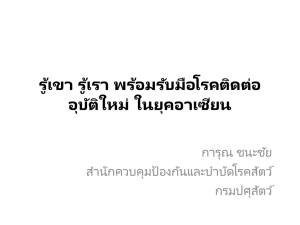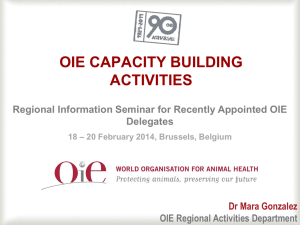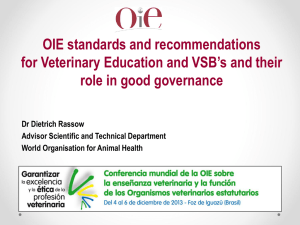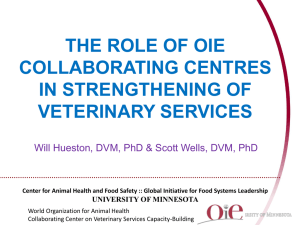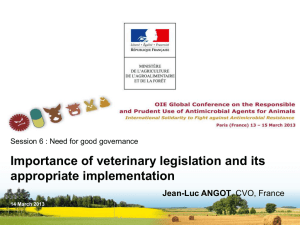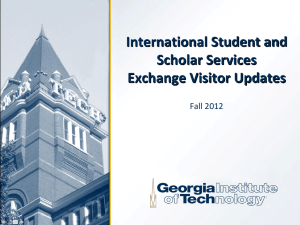Présentation PowerPoint
advertisement
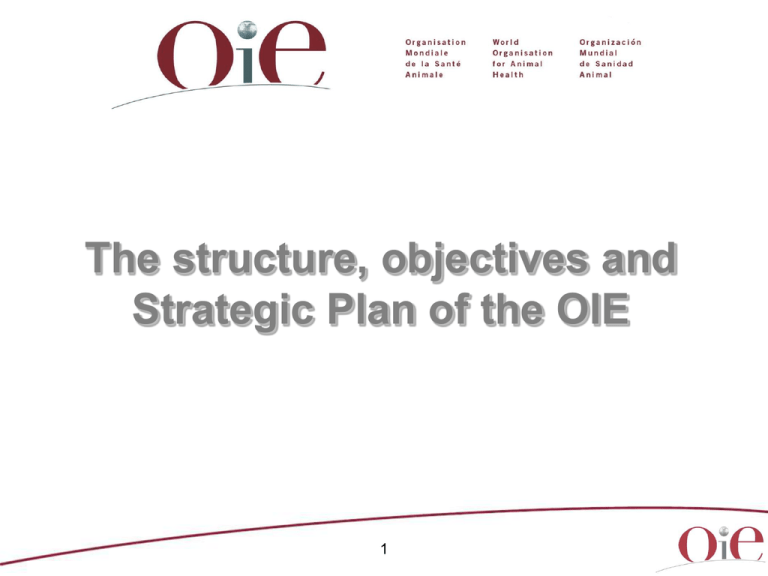
The structure, objectives and Strategic Plan of the OIE 1 THE OIE IN BRIEF 2 CHRONOLOGY An intergovernmental organisation preceding the United Nations 1924 1945 Creation of the Office International des Epizooties (OIE) 2003 Creation of the United Nations World Organisation for Animal Health In 2010 Headquarters in 5 Regional 6 Sub-Regional Paris (France) Representations Representations 3 178 Member Countries in 2010 Africa 52 – Americas 30 – Asia, the Far East and Oceania 36 Europe 53 – Middle-East 20 Some countries belong to more than one region 4 Financing of the OIE Statutory contributions Voluntary contributions 6 categories of statutory contributions World Animal Health and Welfare Fund Member Countries on the United Nations’ list of “Least Developed Countries” benefit from a 50% reduction of their statutory contribution Funding by countries hosting OIE offices in support of their activities Part of the Members’ statutory contributions is compulsorily used to finance the Organisation’s Regional Representations operations Specific donations e.g. grants to buy buildings 5 Currently, the main donors to the World Fund are: Australia, Canada , European Union, France, Italy, Japan, New Zealand, Switzerland United Kingdom, United States of America, World Bank, STRUCTURE OF THE OIE 6 Governance structure of the OIE 1/13 World Assembly of Delegates Council Specialist Commissions Code, Aquatic Animals, Laboratories, and Scientific Reference Laboratories Regional Commissions Director General Headquarters Collaborating Centres Regional Representations 7 Working Groups Ad hoc Groups Governance structure of the OIE 2/13 World Assembly of Delegates • Highest authority of the OIE; formulates decisions by means of Resolutions • Adopts the OIE standards published in the Codes and Manuals • Comprises all national Delegates to the OIE • • Meets at least once a year Approves the official disease status of Members and the list of OIE Collaborating Centres and Reference Laboratories • Elects the members of the OIE Council • Elects the Director General for a five-year term of office • Elects the members of the Specialist Commissions » 8 one Member = one vote Governance structure of the OIE 3/13 The Council 1/2 • Members of the Council are elected for a three-year term of office • The current Council was elected for the period 2009 – 2012 • Represents the World Assembly of Delegates in the interval between General Sessions • Examines technical and administrative items to be presented to the World Assembly of Delegates for approval: • Comments on the OIE technical programme of work • Approves the OIE provisional budget and its implementation 9 Governance structure of the OIE 4/13 The Council 2/2 President Dr Carlos Correa Messuti (Uruguay) May 2010 Past President Vice-President Dr Barry O’Neil (New Zealand) To be elected 10 Members Dr Brian R. Evans (Canada) Dr Florência Cipriano (Mozambique) Dr Rachid Bouguedour (Algeria) Dr Tenzin Dhendup (Bhutan) Dr Nikolay Vlasov (Russia) Dr Nasser Eddin AlHawamdeh (Jordan) Governance structure of the OIE 5/13 The Director General The OIE is managed by the OIE Headquarters in Paris, placed under the responsibility of a Director General elected by secret ballot by the World Assembly of Delegates. In 2010, Dr Bernard Vallat was elected Director General of the World Organisation for Animal Health for a third five-year term. 11 Governance structure of the OIE 6/13 12 Governance structure of the OIE 7/13 Specialist Commissions 1/2 The Specialist Commissions are elected by the World Assembly of Delegates for a period of three years. Their role is to use relevant scientific information to: • • • study epidemiological issues, especially the prevention and control methods of animal diseases develop, update and propose OIE’s international standards and guidelines for adoption by the World Assembly address scientific and technical issues raised by Members, with the exception of bilateral trade problems, for which the OIE has an inhouse mediation procedure should the relevant Members request it 13 Specialist Commissions Governance structure of the OIE 8/13 2/2 Terrestrial Animal Health Standards Commission “Code Commission” Scientific Commission for Animal Diseases “Scientific Commission” Aquatic Animal Health Standards Commission “Aquatic Animals Commission” Responsible for updating the Terrestrial Animal Health Code annually; proposes new standards for adoption by the World Assembly of Delegates. Assists in identifying the most appropriate strategies and measures for the following: Compiles information on diseases of fish, molluscs, crustaceans and amphibians and recommends appropriate prevention and control methods for these diseases. Responsible for ensuring that the Code reflects current scientific information. • disease prevention and control • disease surveillance • examining Members’ request regarding their official animal health status, for countries that wish to be included on the OIE official list of countries or zones free from certain diseases Responsible for updating the Aquatic Animal Health Code and the Manual of Diagnostic Tests for Aquatic Animals; and for proposing new standards for adoption by the World Assembly of Delegates. 14 Biological Standards Commission “Laboratories Commission” Establishes or approves methods for: • diagnostic of diseases of mammals, birds and bees • defining quality criteria of biological products such as vaccines, used for disease control purposes Oversees production and adoptionof the Manual of Diagnostic Tests and Vaccines for Terrestrial Animals. Advises the Director General in supervising the global network of OIE Reference Laboratories and Collaborating Centres (227 worldwide in 2010). Governance structure of the OIE 9/13 Regional Commissions The OIE has set up five Regional Commissions to express specific issues Members in the different regions face. The Bureau of these Commissions counts four Delegates elected by the World Assembly of Delegates for a three-year term of office. It represents the Members between the Regional Commissions’ meetings. » Each Regional Commission holds a Conference every two years in one of the countries of the region. Each Commission also meets every year on the margin of the World Assembly of Delegates. The following regions host Regional Commissions: » The Conferences focus on technical items and on regional cooperation relating to animal disease control. » The Commissions can fully be considered as regional institutions. • • • • • Africa Americas Asia, the Far East and Oceania Europe Middle East 15 Governance structure of the OIE 10/13 These representations closely collaborate with Regional Commissions and are directly under the Director General’s authority. 16 Governance structure of the OIE 11/13 Working Groups Ad hoc Groups These Groups are set up by the Director General as and when needed: OIE Working Groups are responsible for constantly reviewing developments in their field of competence and for keeping OIE Specialist Commission and the Director General informed of current issues through scientific meetings. • to prepare recommendations for submission to Specialist Commissions and Working Groups The fields of competence are: • • • • with internationally renowned scientists who often belong to OIE Reference Centres Animal welfare Animal production food safety Wildlife Their membership is submitted to the World Assembly of Delegates. 17 Governance structure of the OIE 12/13 The Delegate • Nominated by his/her Government • Usually the Chief Veterinary Officer of his/her country » Responsible for negotiating international veterinary standards on behalf of his/her country • Member of the World Assembly of Delegates (which meets in General Session) » Notifies the OIE of the animal disease situation in his/her country • National focal point for the OIE in the country • Official national and international status 18 Governance structure of the OIE 13/13 National Focal Points Focal Points are nominated by the Delegate for each of the following fields: • Aquatic animal diseases • Communication • Wildlife • Animal welfare • Animal disease notification • Animal production food safety • Veterinary products NB: It is planned to propose focal points for Veterinary Laboratories shortly. 19 The OIE’s scientific network 1/4 Reference Laboratories 1/2 Expert centres for animal diseases • Develop, perform and validate diagnostic tests • Provide scientific and technical training to Members • Store and distribute reference reagents • Are under the responsibility of an expert of reference • Organise laboratory proficiency testing of other Members’ laboratories • The list of Reference Laboratories is validated by the World Assembly of Delegates annually • Coordinate scientific and technical studies 20 The OIE’s scientific network 2/4 Reference Laboratories 2/2 190 Reference Laboratories 101 diseases or topics May 2010 21 The OIE’s scientific network 3/4 Collaborating Centres 1/2 Centres of excellence on horizontal topics • Assist in the development of procedures to update and promote international standards and guidelines on animal health and welfare • Coordinate scientific studies • Organise training seminars • Organise and host technical meetings in collaboration with the OIE 22 The OIE’s scientific network 4/4 Collaborating Centres 2/2 37 Collaborating Centres in 21 countries 35 topics May 2010 23 INTERNATIONAL RELATIONS 24 Permanent institutional cooperation with public global partner organisations 1/2 In 2010 WHO - World Health Organization FAO - Food and Agriculture Organization WTO - World Trade Organization IPPC - International Plant Protection Convention World Bank CABI - CAB International ILRI - International Livestock Research Institute 25 Public global partner organisations 2/2 ICMM – International Committee of Military Medecine WMO – World Meteorological Organization WIPO – World Intellectual Property Organization WCO – World Customs Organization ICES – International Council for the Exploration of the Sea ICLAS – International Council for Laboratory Animal Science UNEP – United Nations Environment Programme CBD – Convention on Biological Diversity BTWC – Biological and Toxins Weapons Convention 26 Technical and scientific cooperation with global private sector bodies 1/2 IMS International Meat Secretariat IDF International Dairy Federation FEI Fédération Equestre Internationale SSAFE Safe Supply of Affordable Food Everywhere initiative IEC International Egg Commission IFAH International Federation for Animal Health IFAP International Federation of Agricultural Producers 27 Global private sector bodies 2/2 IABs International Association for Biologicals WVA World Veterinary Association WAVLD World Association of Veterinary Laboratory Diagnosticians IPC International Poultry Council IATA International Air Transport Association WSPA World Society for the Protection of Animals 28 Technical and scientific cooperation with regional public organisations 1/2 European Commission CEBEVIRHA Andean Community PVC AOAD SPC IICA PAHO AU-IBAR ECOWAS OIRSA SADC IDB 29 Regional public organisations 2/2 ASEAN - Association of the South East Asian Nations SAARC - South Asian Association for Regional Cooperation WAEMU - West African Economic and Monetary Union SEAFDC - Southeast Asian Fisheries Development Center 30 FIFTH STRATEGIC PLAN 2011 - 2015 31 A mandate far wider than when the OIE was created 1/14 The OIE was created in 1924 To prevent the spread of animal diseases throughout the world The 4th Strategic Plan 2006-2010 extended the OIE’s mandate to “The improvement of animal health worldwide” 32 Fifth Strategic Plan 2011-2015 2/14 First, continuing to consolidate major objectives of the 4th Strategic Plan Transparency of world animal disease situation (including zoonoses) Collect and publish veterinary scientific information, notably animal disease prevention and control methods Sanitary safety of international trade in animals and their products under the mandate given by the WTO Improve animal health and welfare worldwide 33 Fifth Strategic Plan 2011-2015 3/14 Improve animal health, veterinary public health, animal welfare, and consolidate the animal’s role worldwide 34 Fifth Strategic Plan 2011-2015 Reinforcing priority missions 4/14 Food security • Food security (from quantitative and qualitative perspective) is a key public health concern Food safety • Need for a global supply of safe food • The Veterinary Services must play a key role in protecting consumers • Healthy animals guarantee food security and food safety 35 Fifth Strategic Plan 2011-2015 Reinforcing priority missions 5/14 Animal welfare: a strategic commitment by the OIE • Animal health is a key component of animal welfare • The OIE is recognised worldwide as the leader in developing international standards on animal welfare 36 Fifth Strategic Plan 2011-2015 Reinforcing priority missions 6/14 Good governance of Veterinary Services • Need for suitable legislation and its implementation through effective national animal health systems • Need to guarantee surveillance, early detection and rapid response to disease outbreaks thanks to a national chain of command and good diagnostic capacities • A responsibility of governments • Alliances between the public and private sector (farmers, private veterinarians, consumers) are key • Support to the quality of Services through the use of OIE PVS tool (evaluation and gap analysis of international standards) • Initial and continuing veterinary education • Applied research 37 Fifth Strategic Plan 2011-2015 Reinforcing priority missions 7/14 Capacity building • The Delegates and their competent team in particular the national focal points • The Regional Representations strengthening of teams, to organise support to Delegates and focal points • Developing relations between the Regional Representatives and the elected Bureaux of the Regional Commissions • Continuing with the capacity building programmes for Delegates and focal points through a global permanent calendar of meetings organised by the OIE and its regional and sub-regional offices 38 Fifth Strategic Plan 2011-2015 Reinforcing priority missions 8/14 Scientific excellence • Strengthening of OIE Laboratories networks • Developing laboratory twinning schemes and specific laboratory support projects to extend the OIE network, especially in developing countries • These schemes contribute to reinforcing the veterinary scientific community in developing countries in order to facilitate their involvement in controlling animal disease worldwide and in negotiating the continuous up-date of international standards of the OIE and Codex Alimentarius Collaborating 39 Centres and Reference Fifth Strategic Plan 2011-2015 Reinforcing priority missions 9/14 Influence on animal health management worldwide • development of ambitious OIE communication strategies • continued efforts to persuade multilateral and bilateral organisations that compliance of Veterinary Services with OIE quality standards is a real public good at a national and world level and a global investment priority • strengthening the OIE’s regional and global influence on animal health governance policies and promoting scientific research and veterinary education policies • Global use of the PVS pathway 40 Fifth Strategic Plan 2011-2015 Reinforcing priority missions 10/14 Influence on national policies • Convincing governments of the importance of the OIE Delegate • Convincing governments that they should invest more in animal disease surveillance and prevention, since this represents a low-cost form of insurance compared with the high costs linked with the management of sanitary crisis • Carrying out economic studies at a worldwide level, to demonstrate that prevention is cheaper than crisis management • Helping the Delegates of developing countries to increase their participation in the standard-setting process and in meetings of the WTO SPS Committee, of the Codex Committees and of the OIE • Organisation of regional and national seminars for the training of Veterinary Services and their partnerships with the private sector 41 Fifth Strategic Plan 2011-2015 Reinforcing priority missions 11/14 « Treatment » Capacity Building, Specific Activities, Projects and Programs Veterinary Legislation « Diagnosis » « Prescription » PVS Evaluation PVS Gap Analysis including Veterinary Services’ Strategic Priorities The OIE collaborates with governments, donors and other stakeholders Public / Private Partnerships Veterinary Education Laboratories 42 PVS Pathway Follow-Up Missions Fifth Strategic Plan 2011-2015 Reinforcing priority missions 12/14 Communication Promote animal and veterinary public health policies Develop and spread an international communication strategy on OIE objectives Reinforce Veterinary Services capacities in the field of communication Send appropriate messages to the general public, decision-makers and OIE partners 43 Fifth Strategic Plan 2011-2015 New actions 13/14 One Health A worldwide strategy for managing risks at the animal-human interface ecosystems Veterinary education International recognition of veterinary qualifications and promotion of professional excellence throughout the world OIE Worldwide Conference of Deans of veterinary education establishments and permanent follow-up 44 Fifth Strategic Plan 2011-2015 New actions 14/14 Relation between animal production and the environment New sanitary and environmental risks need to be anticipated Impact of climate and environmental change on the emergence of animal diseases Relationship between animal production systems and climate change 45 Conclusion The Strategic Plans implemented through the Director General’s work programme will continue to show that, since 1924 OIE activities are a global public good for the International Community, and that the cost to Members is negligible compared to the services it provides 46 OIE PUBLICATIONS AND WEB SITE 47 Publications • Scientific and Technical Review - every 4 months • Terrestrial animal Health code – once a year • Aquatic Animal Health Code – once a year • Manual of Diagnostic Tests for Aquatic Animals • Manual of Diagnostic Tests and Vaccines for Terrestrial Animals. • World Animal Health - once a year • Bulletin - every 3 months • Technical Items, information brochures, thematic publications - variable frequency 48 On the OIE website www.oie.int • Disease alerts • Global animal disease situation • • International Standards on Animal Health and Welfare (Codes, Manuals), Guidelines, Recommendations, etc. • General and scientific information on OIE activities • Editorials from the Director General, press releases • Media Resources Scientific and Technical Review 49 Thank you for your attention Organisation mondiale de la santé animale World Organisation for Animal Health Organización Mundial de Sanidad Animal 12 rue de Prony, 75017 Paris, France - www.oie.int – oie@oie.int
